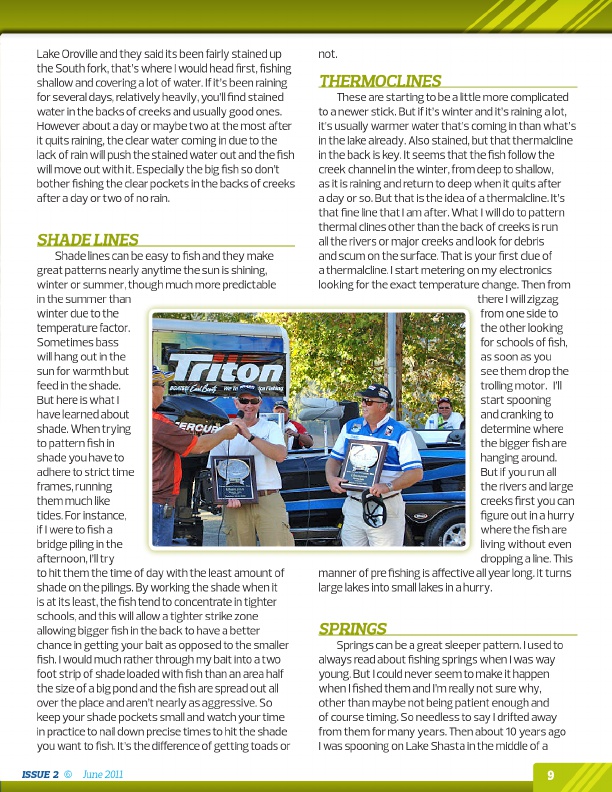
Lake Oroville and they said its been fairly stained up the South fork, that’s where I would head first, fishing shallow and covering a lot of water. If it’s been raining for several days, relatively heavily, you’ll find stained water in the backs of creeks and usually good ones. However about a day or maybe two at the most after it quits raining, the clear water coming in due to the lack of rain will push the stained water out and the fish will move out with it. Especially the big fish so don’t bother fishing the clear pockets in the backs of creeks after a day or two of no rain.
SHADE LINES
Shade lines can be easy to fish and they make great patterns nearly anytime the sun is shining, winter or summer, though much more predictable in the summer than winter due to the temperature factor. Sometimes bass will hang out in the sun for warmth but feed in the shade. But here is what I have learned about shade. When trying to pattern fish in shade you have to adhere to strict time frames, running them much like tides. For instance, if I were to fish a bridge piling in the afternoon, I’ll try to hit them the time of day with the least amount of shade on the pilings. By working the shade when it is at its least, the fish tend to concentrate in tighter schools, and this will allow a tighter strike zone allowing bigger fish in the back to have a better chance in getting your bait as opposed to the smaller fish. I would much rather through my bait into a two foot strip of shade loaded with fish than an area half the size of a big pond and the fish are spread out all over the place and aren’t nearly as aggressive. So keep your shade pockets small and watch your time in practice to nail down precise times to hit the shade you want to fish. It’s the difference of getting toads or
ISSUE 2 June 2011
not.
THERMOCLINES
These are starting to be a little more complicated to a newer stick. But if it’s winter and it’s raining a lot, it’s usually warmer water that’s coming in than what’s in the lake already. Also stained, but that thermalcline in the back is key. It seems that the fish follow the creek channel in the winter, from deep to shallow, as it is raining and return to deep when it quits after a day or so. But that is the idea of a thermalcline. It’s that fine line that I am after. What I will do to pattern thermal clines other than the back of creeks is run all the rivers or major creeks and look for debris and scum on the surface. That is your first clue of a thermalcline. I start metering on my electronics looking for the exact temperature change. Then from
there I will zigzag
from one side to
the other looking
for schools of fish,
as soon as you
see them drop the
trolling motor. I’ll
start spooning
and cranking to
determine where
the bigger fish are
hanging around.
But if you run all
the rivers and large
creeks first you can
figure out in a hurry
where the fish are
living without even
dropping a line. This manner of pre fishing is affective all year long. It turns large lakes into small lakes in a hurry.
SPRINGS
Springs can be a great sleeper pattern. I used to always read about fishing springs when I was way young. But I could never seem to make it happen when I fished them and I’m really not sure why, other than maybe not being patient enough and of course timing. So needless to say I drifted away from them for many years. Then about 10 years ago I was spooning on Lake Shasta in the middle of a
9